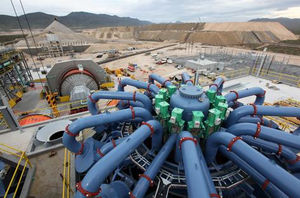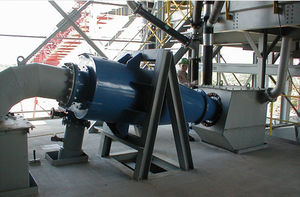
Desulfurization system

Add to favorites
Compare this product
Description
In wet flue gas desulfurization systems, limestone (calcium carbonate) is ground to a powder in a wet ball mill. Krebs cyclones are used to classify the ball mill discharge, returning coarse particles to the ball mill for further grinding. Finely ground limestone (typically 90% passing 45 micron) reports to the cyclone overflow and is stored in a limestone slurry storage tank (at 25-30% solids by weight).
The stored limestone slurry is sprayed counter-currently against the power plant boiler flue gas, absorbing SO2 from the flue gas. The SO2 reacts with oxygen and limestone forming gypsum. Krebs cyclones concentrate the gypsum slurry from about 15% solids by weight to 45% solids by weight ahead of a vacuum belt filter. The vacuum belt filter produces a filter cake that can be disposed of in a landfill or in some cases, processed to make wallboard. The cyclone overflow is returned to the absorber where fine unreacted limestone is converted to gypsum and fine gypsum crystals grow larger.
Frequently, small diameter cyclones are used to process a portion of the overflow from the gypsum dewatering cyclones. The purpose of this stage of cyclones is to produce a relatively solids free (<1.5% solids by weight) stream that can be sent to a wastewater treatment plant as a chloride bleed from the system.
Catalogs
No catalogs are available for this product.
See all of KREBS ENGINEERS‘s catalogsRelated Searches
*Prices are pre-tax. They exclude delivery charges and customs duties and do not include additional charges for installation or activation options. Prices are indicative only and may vary by country, with changes to the cost of raw materials and exchange rates.






